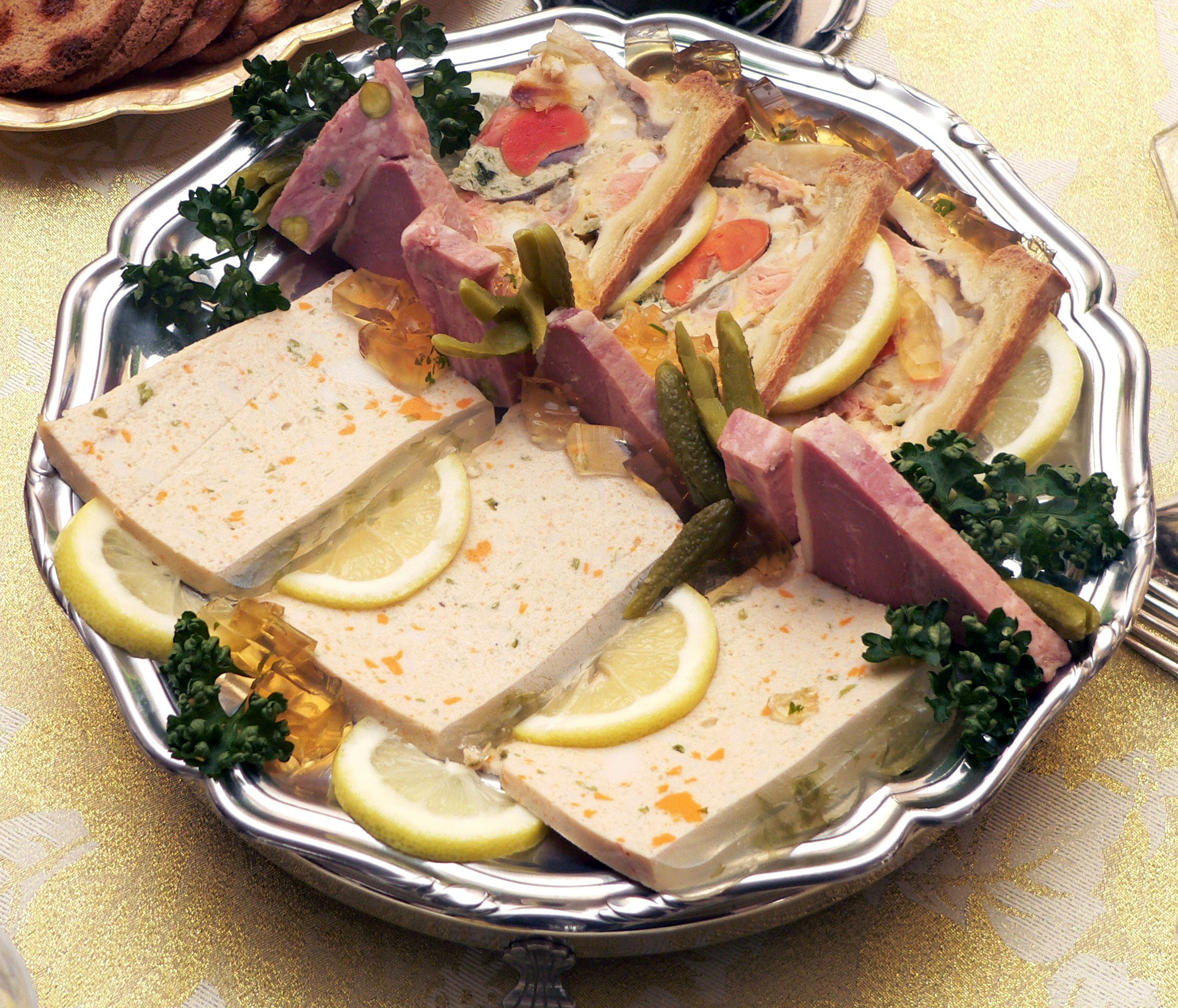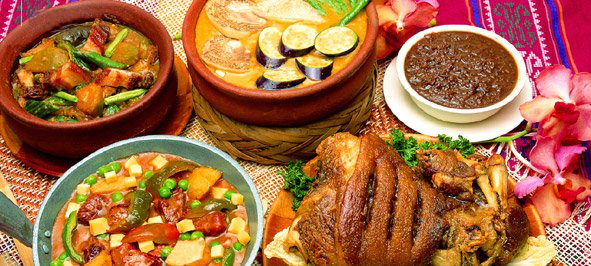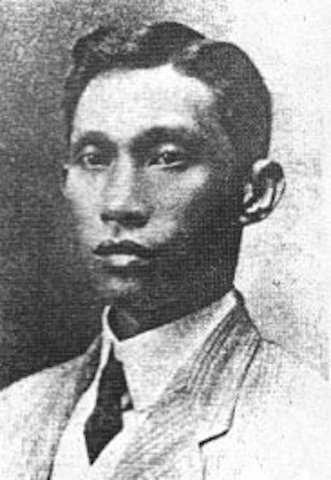|
Igado
''Igado'' (or ''higado'') is a Filipino pork dish originating from the Ilocos Region in the Philippines. Its name means "liver" in Spanish for which it features, although it may include other pork meats and offal also. The pork―liver, meat, and offal―are sliced into tiny pieces and simmered with bell pepper and green peas, producing a dish often likened to the menudo. Unlike menudo, igado typically uses soy sauce (or patis) and vinegar rather than tomato sauce. Also, potatoes and carrots are optional. The dish was a favorite of Elpidio Quirino, an Ilocano, and sixth president of the Philippines. See also * Paklay *Bopis ''Bopis'' (''bópiz'' in Spanish) is a piquant Filipino dish of pork or beef lungs and heart sautéed in tomatoes, chilies and onions. This spicy Filipino dish has Spanish origins, but the meaning in its original language, and even region o ... References Ilocano cuisine Philippine pork dishes {{Philippines-cuisine-stub ... [...More Info...] [...Related Items...] OR: [Wikipedia] [Google] [Baidu] |
Pork Guisantes
''Pork guisantes'' (also spelled as ''gisantes'') or ''pork and peas'' is a Cuisine of Hawaii, Hawaiian pork stew of Filipino cuisine, Filipino origin. Pork is stewed in a tomato sauce base with peas. It is likely an adaptation of the Filipino cuisine, Filipino dishes and introduced by the Ilocano people, Ilocanos from their arrival in the early 1900s who came to work in the fruit and Sugar plantations in Hawaii, sugar plantations. ''Pork guisantes'' remains a popular Filipino cuisine, Filipino-inspired dish catered to the Cuisine of Hawaii, Hawaiian palate. It is featured in ready-to-go bentos at convenience stores, served at local dine-in restaurants, offered as a plate lunch dish, or an Airline meal, in-flight meal option, and as an ''okazu'' item at a few okazuya. Ingredients Meat Unlike and , ''pork guisantes'' does not contain liver (food), liver. Rather, it is more partial to meat such as pork tenderloin or pork butt, butt to cater to a wider population not accustomed ... [...More Info...] [...Related Items...] OR: [Wikipedia] [Google] [Baidu] |
Offal
Offal (), also called variety meats, pluck or organ meats, is the internal organ (anatomy), organs of a butchered animal. Offal may also refer to the by-products of Milling (grinding), milled grains, such as corn or wheat. Some cultures strongly consider offal consumption to be taboo, while others use it as part of their everyday food, such as lunch meats, or, in many instances, as Delicacy, delicacies. Certain offal dishes—including ''foie gras'' and ''pâté''—are often regarded as gourmet food in the culinary arts. Others remain part of traditional regional cuisine and are consumed especially during holidays; some examples are sweetbread, Jewish chopped liver, Scottish haggis, U.S. chitterlings, and Mexican Menudo (soup), menudo. On the other hand, intestines are traditionally used as casing for sausages. Depending on the context, ''offal'' may refer only to those parts of an animal carcass discarded after butchering or skinning; offal not used directly for human or anim ... [...More Info...] [...Related Items...] OR: [Wikipedia] [Google] [Baidu] |
Menudo (stew)
''Menudo'' (from Spanish language, Spanish: "small [bits]"), also known as ''ginamay'' or ''ginagmay'' (Cebuano language, Cebuano: "[chopped into] smaller pieces"), is a traditional stew from the Cuisine of the Philippines, Philippines made with pork and sliced Liver (food), liver in tomato sauce with carrots and potatoes. Unlike the Mexican Menudo (soup), dish of the same name, it does not use tripe, hominy, or red chili sauce. Description The dish is made with garlic, onions, tomatoes, pork, liver as food, liver (pork or beef), diced potatoes, raisins, diced carrots, bell pepper, green bell peppers, soy sauce, vinegar or calamansi, and tomato sauce, and seasoned with Edible salt, salt and Black pepper, pepper. It is one of the most common offerings in ''carinderias'' or ''karinderyas'' (small eateries that offer budget-friendly meals to local residents) and is also commonly served in potlucks or buffets due to the inexpensive ingredients used in the dish. Waknatoy ''Wak ... [...More Info...] [...Related Items...] OR: [Wikipedia] [Google] [Baidu] |
Cuisine Of The Philippines
Filipino cuisine is composed of the cuisines of more than a hundred distinct ethnolinguistic groups found throughout the Philippine archipelago. A majority of mainstream Filipino dishes that comprise Filipino cuisine are from the food traditions of various ethnolinguistic groups and tribes of the archipelago, including the Ilocano, Pangasinan, Kapampangan, Tagalog, Bicolano, Visayan, Chavacano, and Maranao ethnolinguistic groups. The dishes associated with these groups evolved over the centuries from a largely indigenous (largely Austronesian) base shared with maritime Southeast Asia with varied influences from Chinese, Spanish, and American cuisines, in line with the major waves of influence that had enriched the cultures of the archipelago, and adapted using indigenous ingredients to meet local preferences. "Philippine Cuisine." ... [...More Info...] [...Related Items...] OR: [Wikipedia] [Google] [Baidu] |
Bopis
''Bopis'' (''bópiz'' in Spanish) is a piquant Filipino dish of pork or beef lungs and heart sautéed in tomatoes, chilies and onions. This spicy Filipino dish has Spanish origins, but the meaning in its original language, and even region of origin, are now lost. It could be Frito de Matanza, a variation of Frito Mallorquin. Preparation It is sauteed and stir-fried (until crispy) with finely-chopped pig innards and cooked in onion, tomato, garlic, and pepper. Recipes for bopis may differ from region to region and family to family, with regard to ingredients, spices and flavoring. Classified as ''pulutan'' in Filipino cuisine, ''bopis'' is served with alcoholic beverage Drinks containing alcohol (drug), alcohol are typically divided into three classes—beers, wines, and Distilled beverage, spirits—with alcohol content typically between 3% and 50%. Drinks with less than 0.5% are sometimes considered Non-al ...s, or as a main dish with rice. See also * Paklay * ... [...More Info...] [...Related Items...] OR: [Wikipedia] [Google] [Baidu] |
Paklay
''Paklay'' is two different Filipino braised dishes from the Mindanao and Visayas Islands characterized by julienned ingredients. They are eaten with rice or served as ''pulutan'' (side dishes) with alcohol. In Mindanao and Central and Eastern Visayas, it refers to a dish made from various beef, pork, or goat tripe with julienned ginger, bamboo shoots (''labong''), carrots, bell pepper, ''siling mahaba'' chilis and tomatoes, garlic, onions, and black pepper, among other ingredients. It is commonly slightly soured with fruits like pineapple, tamarind, or unripe starfruit. Among the Hiligaynon people of Western Visayas, on the other hand, it refers to sautéed bamboo shoots with fish or shrimp, tomatoes, ground pork or beef, onions, garlic, and other spices. See also * Igado * Bopis * Dinakdakan *Dinuguan ''Dinuguan'' () is a Filipino savory stew usually of pork offal (typically lungs, kidneys, intestines, ears, heart and snout) and/or meat simmered in a rich, spicy da ... [...More Info...] [...Related Items...] OR: [Wikipedia] [Google] [Baidu] |
Ilocano People
The Ilocano people (), also referred to as Ilokáno, Iloko, Iloco, Iluku, or Samtoy, are an Austronesian peoples, Austronesian ethnolinguistic group native to the Philippines. Originally from the Ilocos Region, located on the northwestern coast of Luzon, they have expanded throughout northern and central Luzon, particularly in Cagayan Valley, the Cordillera Administrative Region, and the northern and western parts of Central Luzon. The Ilocanos constitute the third-largest Ethnic groups in the Philippines, ethnolinguistic group in the Philippines. Their native language is called Ilocano language, Iloco or Iloko. Ilocano culture reflects a blend of Catholic Church, Roman Catholic influences and pre-colonial Animism, animist-Polytheism, polytheistic traditions, shaped by their agricultural lifestyle and strong family-communal ties. Beyond the northern Luzon, large Ilocano populations are found in Metro Manila, Mindoro, Palawan, and Mindanao, as well as in the United States, part ... [...More Info...] [...Related Items...] OR: [Wikipedia] [Google] [Baidu] |
Elpidio Quirino
Elpidio Rivera Quirino (; November 16, 1890 – February 29, 1956) was a Philippine nationality law, Filipino lawyer and politician who served as the 6th President of the Philippines from 1948 to 1953. A lawyer by profession, Quirino entered politics when he became a representative of Ilocos Sur's Ilocos Sur's 1st congressional district, 1st district from 1919 to 1922. He was then elected as a senator from 1925 to 1935. In 1934, he became a member of the Philippine Independence Commission that was sent to Washington, D.C., which secured the passage of Tydings–McDuffie Act to the American Congress, United States Congress. In 1935, he was also elected to the 1934 Philippine Constitutional Convention election, 1935 Constitutional Convention that drafted the 1935 Constitution of the Philippines, 1935 Philippine Constitution for the newly established Commonwealth of the Philippines, Philippine Commonwealth. In the new government, he served as secretary of the interior and finance u ... [...More Info...] [...Related Items...] OR: [Wikipedia] [Google] [Baidu] |
Liver As Food
The liver of mammals, fowl, and fish is commonly eaten as food by humans (see offal). Pork, lamb, veal, beef, chicken, goose, and cod livers are widely available from butchers and supermarkets while stingray and burbot livers are common in some European countries. Nutrition Animal livers are rich in iron, copper, B vitamins and preformed vitamin A. Daily consumption of liver can be harmful; for instance, vitamin A toxicity has been proven to cause medical issues to babies born of pregnant mothers who consumed too much vitamin A. For the same reason, consuming the livers of some species like polar bears, dogs, or moose is unsafe. A single slice (68 g) of beef liver exceeds the tolerable upper intake level of vitamin A (6410 μg preformed vs. UL for preformed = 3000 μg). 100 g cod liver contains 5 mg of vitamin A and 100 μg of vitamin D. Liver contains large amounts of vitamin B12, and this was one of the factors that led to the discovery of t ... [...More Info...] [...Related Items...] OR: [Wikipedia] [Google] [Baidu] |
Pork
Pork is the culinary name for the meat of the pig (''Sus domesticus''). It is the most commonly consumed meat worldwide, with evidence of pig animal husbandry, husbandry dating back to 8000–9000 BCE. Pork is eaten both freshly cooked and preserved; Curing (food preservation), curing extends the shelf life of pork products. Ham, Gammon (meat), gammon, bacon, and sausage, pork sausage are examples of preserved pork. Charcuterie is the branch of cooking devoted to prepared meat products, many from pork. Pork is the most popular meat in the Western world, particularly in Central Europe. It is also very popular in East Asia, East and Southeast Asia (Mainland Southeast Asia, Philippines, Singapore, and East Timor). The meat is highly prized in Asian cuisines, especially in China (including Hong Kong) and Northeast India, for its fat content and texture. Some religions and cultures Religious restrictions on the consumption of pork, prohibit pork consumption, notably Islami ... [...More Info...] [...Related Items...] OR: [Wikipedia] [Google] [Baidu] |
Philippines
The Philippines, officially the Republic of the Philippines, is an Archipelagic state, archipelagic country in Southeast Asia. Located in the western Pacific Ocean, it consists of List of islands of the Philippines, 7,641 islands, with a total area of roughly 300,000 square kilometers, which are broadly categorized in Island groups of the Philippines, three main geographical divisions from north to south: Luzon, Visayas, and Mindanao. With a population of over 110 million, it is the world's List of countries and dependencies by population, twelfth-most-populous country. The Philippines is bounded by the South China Sea to the west, the Philippine Sea to the east, and the Celebes Sea to the south. It shares maritime borders with Taiwan to the north, Japan to the northeast, Palau to the east and southeast, Indonesia to the south, Malaysia to the southwest, Vietnam to the west, and China to the northwest. It has Ethnic groups in the Philippines, diverse ethnicities and Culture o ... [...More Info...] [...Related Items...] OR: [Wikipedia] [Google] [Baidu] |
Ilocos Region
The Ilocos Region (; ; ), designated as Region I, is an Region of the Philippines, administrative region of the Philippines. Located in the northwestern section of Luzon, it is bordered by the Cordillera Administrative Region to the east, the Cagayan Valley to the northeast and southeast, Central Luzon to the south, and the West Philippine Sea to the west. The region comprises four provinces: Ilocos Norte, Ilocos Sur, La Union, and Pangasinan, along with one independent city, Dagupan, Dagupan City. The regional center is the San Fernando, La Union, City of San Fernando in La Union, which serves as the administrative hub of the region. The largest settlement in terms of population is San Carlos, Pangasinan, San Carlos City in Pangasinan. The 2020 Philippine Statistics Authority census reported that the ethnolinguistic group composition of the region is predominantly made up of Ilocano language, Ilocanos (58.3%), followed by Pangasinan language, Pangasinans (29.7%), Tagalog langua ... [...More Info...] [...Related Items...] OR: [Wikipedia] [Google] [Baidu] |







